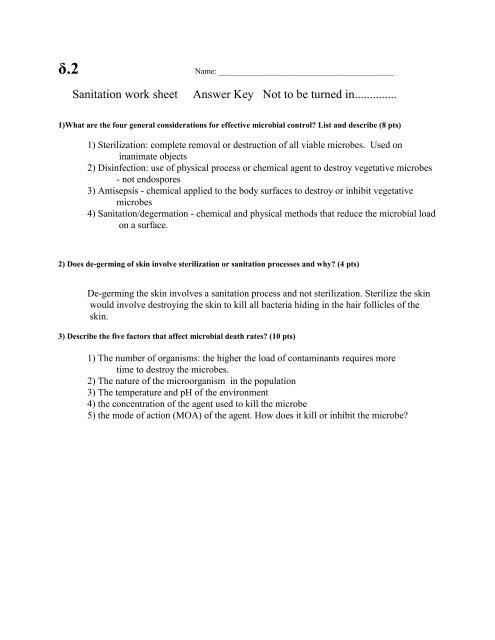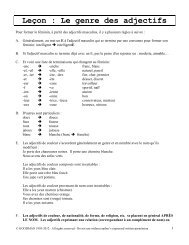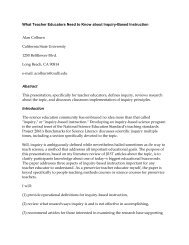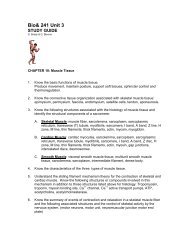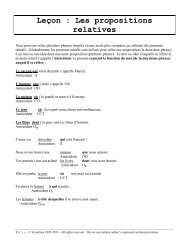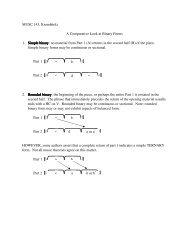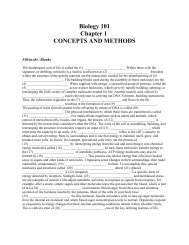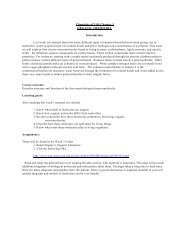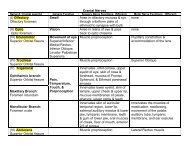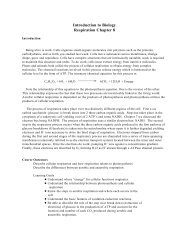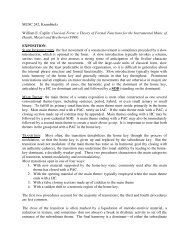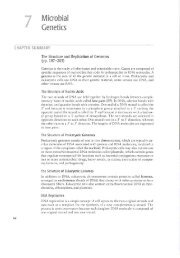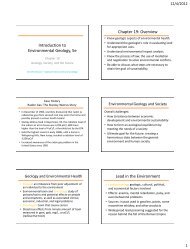Sanitation work sheet Answer Key Not to be turned in..............
Sanitation work sheet Answer Key Not to be turned in..............
Sanitation work sheet Answer Key Not to be turned in..............
Create successful ePaper yourself
Turn your PDF publications into a flip-book with our unique Google optimized e-Paper software.
ä.2 Name: ___________________________________________<strong>Sanitation</strong> <strong>work</strong> <strong>sheet</strong><strong>Answer</strong> <strong>Key</strong> <strong>Not</strong> <strong>to</strong> <strong>be</strong> <strong>turned</strong> <strong>in</strong>..............1)What are the four general considerations for effective microbial control? List and descri<strong>be</strong> (8 pts)1) Sterilization: complete removal or destruction of all viable micro<strong>be</strong>s. Used on<strong>in</strong>animate objects2) Dis<strong>in</strong>fection: use of physical process or chemical agent <strong>to</strong> destroy vegetative micro<strong>be</strong>s- not endospores3) Antisepsis - chemical applied <strong>to</strong> the body surfaces <strong>to</strong> destroy or <strong>in</strong>hibit vegetativemicro<strong>be</strong>s4) <strong>Sanitation</strong>/degermation - chemical and physical methods that reduce the microbial loadon a surface.2) Does de-germ<strong>in</strong>g of sk<strong>in</strong> <strong>in</strong>volve sterilization or sanitation processes and why? (4 pts)De-germ<strong>in</strong>g the sk<strong>in</strong> <strong>in</strong>volves a sanitation process and not sterilization. Sterilize the sk<strong>in</strong>would <strong>in</strong>volve destroy<strong>in</strong>g the sk<strong>in</strong> <strong>to</strong> kill all bacteria hid<strong>in</strong>g <strong>in</strong> the hair follicles of thesk<strong>in</strong>.3) Descri<strong>be</strong> the five fac<strong>to</strong>rs that affect microbial death rates? (10 pts)1) The num<strong>be</strong>r of organisms: the higher the load of contam<strong>in</strong>ants requires moretime <strong>to</strong> destroy the micro<strong>be</strong>s.2) The nature of the microorganism <strong>in</strong> the population3) The temperature and pH of the environment4) the concentration of the agent used <strong>to</strong> kill the micro<strong>be</strong>5) the mode of action (MOA) of the agent. How does it kill or <strong>in</strong>hibit the micro<strong>be</strong>?
4) Descri<strong>be</strong> the four modes of action for a good antimicrobial agents. (8 pts)1) Cell wall, 2) cell membrane; 3) cellular synthesis processes (DNA RNA);4) Denaturation of Prote<strong>in</strong>1) Cell Wall:a)Block<strong>in</strong>g cell wall synthesis;b) digest<strong>in</strong>g the cell wall;c) break<strong>in</strong>g down the cell wall i.e. penicill<strong>in</strong>, detergents and alcohols2) Cell membranea) surfactants: lower surface tension of cell membranes disrupt<strong>in</strong>g phospholipidbi-layer result<strong>in</strong>g <strong>in</strong> leaky membranes3) cellular biosynthesis of DNA RNAa) agents irreversibly b<strong>in</strong>ds <strong>to</strong> DNA prevent<strong>in</strong>g it transcriptionb) agents can cause mutations <strong>in</strong> cod<strong>in</strong>g genes4) Altered Prote<strong>in</strong> functiona) Denaturation of 3D structureb) Metallic ions b<strong>in</strong>d <strong>to</strong> active sites of prote<strong>in</strong>s prevent<strong>in</strong>g <strong>in</strong>teractions withsubstrates5) Compare and contrast the relative effectiveness of moist heat <strong>to</strong> that of dry heat?(Please make a Table for this descriptive purpose (12 pts))Moist heat:Dry heat :Steam under pressureAu<strong>to</strong>clave 121C for 15 m<strong>in</strong> vs. 134C for 3 m<strong>in</strong>Non-pressurized steamTyndallization <strong>in</strong>termittent sterilization repeated heat<strong>in</strong>gcycles over 60 m<strong>in</strong> time several times repeated.Boil<strong>in</strong>g waterBoil<strong>in</strong>g water (100C for 30 m<strong>in</strong>utes) does not kill resistant spore<strong>be</strong> will kill most non-spore form<strong>in</strong>g micro<strong>be</strong>sPasteurization (See table provided dur<strong>in</strong>g lecture)Oven heat at 121C for 120 m<strong>in</strong>utes vs. 170 for 60 m<strong>in</strong>utesDehydrates cellsDenature cellsOxidizes cells6) What is considered an effective temperature and time for the Pasteurization of milk products withoutdestroy<strong>in</strong>g milk favor? (4 pts)Flash method: 71.6C for 15 seconds. This method is preferable <strong>be</strong>acuse it is lesslikely <strong>to</strong> change flavor or nutrient content and effective aga<strong>in</strong>st Coxiella andMycobacterium.
7) Draw, annotate and discuss the follow<strong>in</strong>g graphs for a good bacteriostatic, bacteriocidal, and bacteriolyticagents upon microbial population. (La<strong>be</strong>l the graph) (12 pts)See attached appendix material8) Ultra violet (U.V.) radiation can <strong>be</strong> used for sterilization. At what frequency does U.V. radiation <strong>work</strong> at;What is it’s mode of action; B) limitations and C) where would UV light <strong>be</strong> used <strong>to</strong> control micro<strong>be</strong>s? (5 pts)A frequency of 185 and 260~5 nm. Mode of Action (MOA) surface sterilant caus<strong>in</strong>gpyrimid<strong>in</strong>e dimers, also caus<strong>in</strong>g pho<strong>to</strong>chemical products called free radicals. UVradiation passes through air slightly through liquids, and poorly through solids. Used <strong>in</strong>hospital rooms, operat<strong>in</strong>g tables, food preparation areas, and dental offices. Also used <strong>to</strong>curtail the growth of micro<strong>be</strong>s <strong>in</strong> food process<strong>in</strong>g plants and slaughterhouse.9) How is food lyophiliz<strong>in</strong>g? Is a food product sterilized by this method? Why or why not? (6 pts)Food is freeze dried at low temperatures low pressure. Micro<strong>be</strong>s require water <strong>to</strong> live andare not necessarily killed by this method of food preservation. Upon rehydrationmicrobial decay once aga<strong>in</strong> <strong>be</strong>g<strong>in</strong> its activity.10) How does cool<strong>in</strong>g cooked food products down <strong>to</strong> 3.3C reduce spoilage? Expla<strong>in</strong>! Does freez<strong>in</strong>gtemperature kill micro<strong>be</strong>s such as Clostriduim? Why (6 pts)Most food destroy<strong>in</strong>g micro<strong>be</strong>s live <strong>be</strong>st at 37C. Cool<strong>in</strong>g food <strong>to</strong> 3.3C reduces afavorable environment for microbial growth but does not necessarily s<strong>to</strong>p its growth. Onthe other hand, while freez<strong>in</strong>g s<strong>to</strong>ps microbial growth it does not kill micro<strong>be</strong>s such asClostriduim.
11) Provide 3 examples that antiseptic methods can <strong>be</strong> employed <strong>to</strong> prevent bacterial entry <strong>in</strong><strong>to</strong> the humanblood system <strong>in</strong> the medical profession (6 pts)1) Prepar<strong>in</strong>g the sk<strong>in</strong> <strong>be</strong>fore surgical <strong>in</strong>cisions with iod<strong>in</strong>e compounds2) Swabb<strong>in</strong>g an open root canal with hydrogen peroxide3) Ord<strong>in</strong>ary hand wash<strong>in</strong>g with a germicidal soap12) What is the mode of action of chor<strong>in</strong>e, soaps, and heavy metals? (9 pts)Chlor<strong>in</strong>eorganic oxidant of sulfhydryl groupsand <strong>in</strong>terferes with disulfide bridges.Highly affect dis<strong>in</strong>fectants andantiseptics Toxic <strong>to</strong> liv<strong>in</strong>g tissuessoups sufactants emulsifies micro<strong>be</strong>s anddisrupts their membrane<strong>in</strong>tegrityHeavy metals (Z<strong>in</strong>c, silver, mercury) B<strong>in</strong>ds <strong>to</strong> Metals are very <strong>to</strong>xic <strong>to</strong> humans iffunctional prote<strong>in</strong> groups <strong>in</strong>gested, <strong>in</strong>haled, or absor<strong>be</strong>d<strong>in</strong>-activat<strong>in</strong>g them. through the sk<strong>in</strong>. Causes allergicreactionsG:\Tests\Microbiology Test\Work <strong>sheet</strong>\<strong>Sanitation</strong>\Micro 231 Lec Test 3 F06 take home_answers B.wpdAppendix
Log ofCellsTotal CountViable CountBacteriostaticTime
Log ofCellsBacteriocidalTime
Log ofCellsBacteriolyticTime


